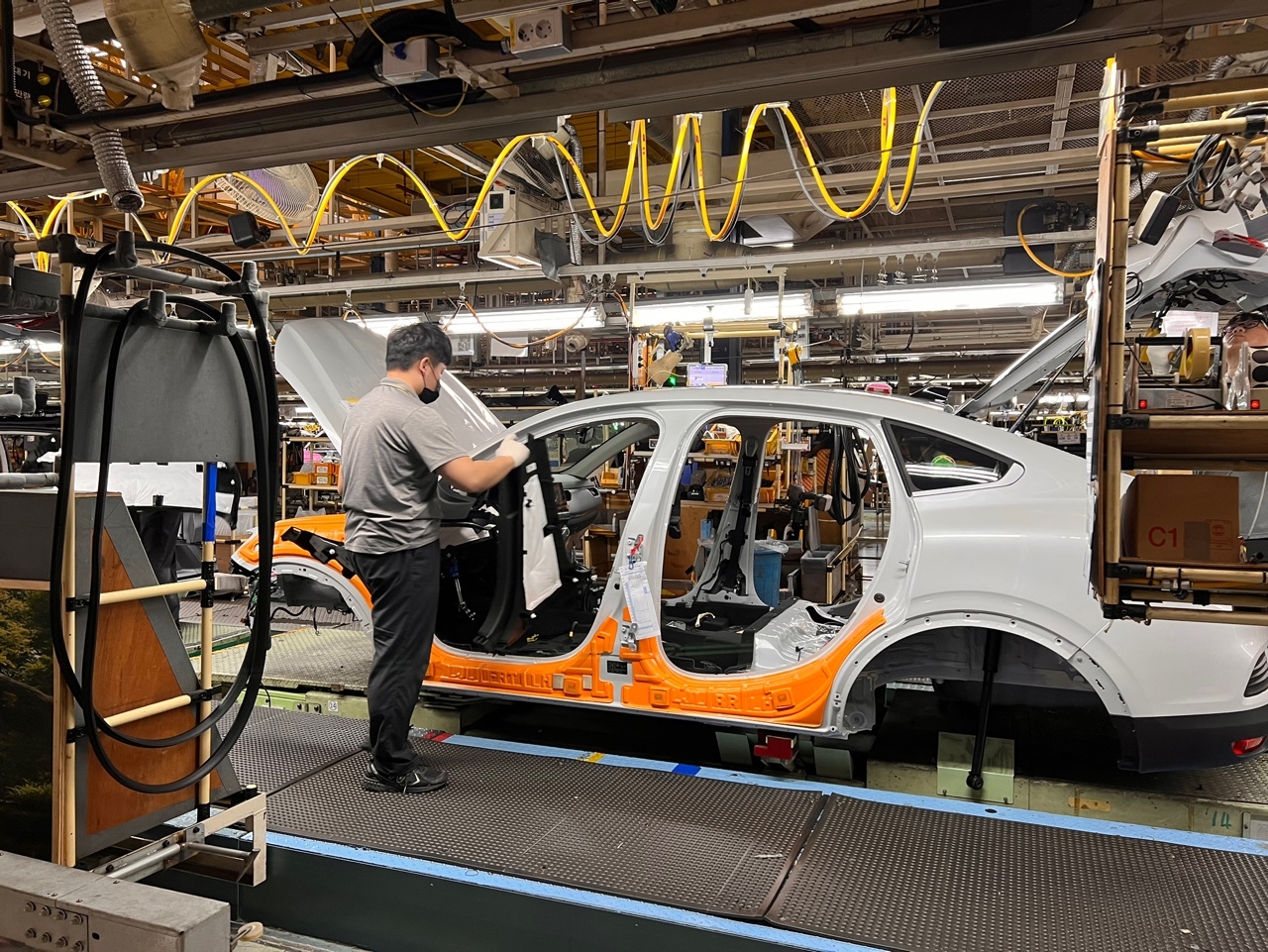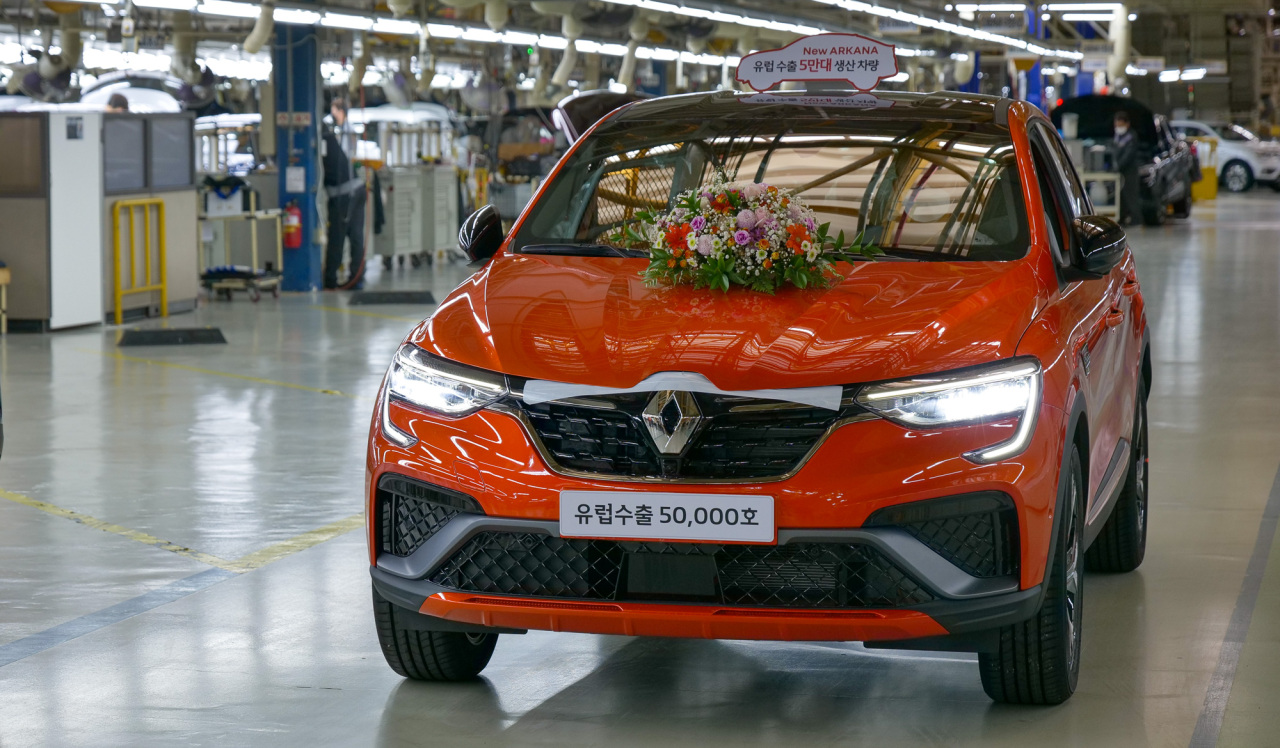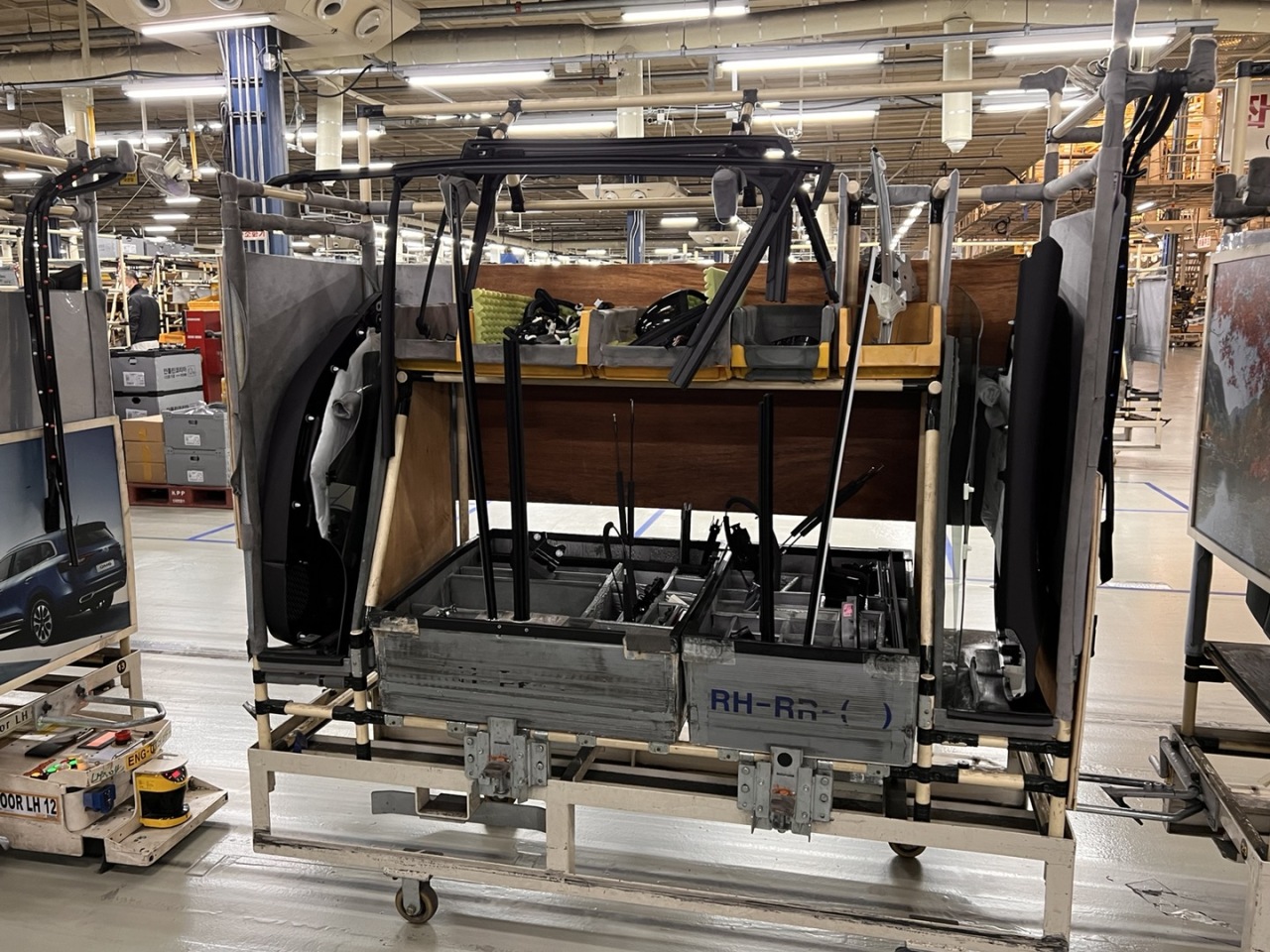[From the Scene] Versatility drives Renault Samsung’s Busan plant
Mixed production assembly line in Busan plant is key to productivity
By Jo He-rimPublished : Nov. 11, 2021 - 17:14

BUSAN -- While factories usually have one flagship item manufactured on one assembly line to maximize productivity, Renault Samsung Motors’ Busan automotive plant has increased competitiveness by making its lines able to produce more than one.
With the versatile assembly line, the Busan plant is in fully geared up to boost exports of Renault Samsung’s global flagship sport utility vehicle XM3, known as Arkana overseas, said Lee Hae-jin, director at Renault Samsung Motors’ manufacturing division.
Celebrating the production of the 50,000th XM3 on Tuesday, the automaker took media outlets on a tour of the manufacturing plant in Busan, responsible for producing the global flagship sport utility vehicle.
At the Busan plant, three vehicles are currently produced on one assembly line -- QM6 and XM3 in the sport utility vehicle lineup and SM6, the sedan. Twizy, a small electric vehicle is also OEM-manufactured there.
Outside Korea, QM6 is sold under the name Koleos, SM6 is called Talisman, and XM3, the new Arkana.
At the entrance to Renault Samsung Motor’s headquarters, a placard reads, “New Arkana is the key to our survival.” And Lee said the message rings true.
“The maximum production capacity of the Busan plant is 150,000 units to 200,000 units in a year, but domestic demand can only go as high as 100,000 units for now,” Lee said.
“Arkana’s contribution in increasing the total output of the plant is very important, and we hope to cut down on fixed costs in operating the factory and improve profitability.”

The Arkana was introduced for the first time in South Korea as the XM3 in March 2020. After gaining popularity here, the model has been launched in 28 countries, starting with Chile in July last year. Tapping into European markets, including in France, Germany, Italy and Spain with the new name Arkana, the accumulated export volume for the compact SUV quickly grew to surpass the 50,000-mark last week.
“The export volume of over 50,000 units is better than our expectations, and it proves of the competitiveness Arkana has in Europe, and also of the quality competitiveness of Busan plant,” Lee said.
By country, the automaker sold 19,737 units of Arkana in France, 6,245 units in Spain, 5,785 units in Germany and 4,275 units in Italy, since the model was launched in Europe in December.
As of the end of this year, the company said it expects the accumulated production volume to reach 60,000, and also plans to raise the production to 130,000 units of the SUV, with 100,000 of them for export.
Inside the Busan plant are four shops: stamping, body welding, painting and assembling.
The manufacturing process begins from the Stamping Shop, where robots stamp out different parts of a car such as the body, doors and engine compartments from metal sheets.

The sheets are then processed to be delivered, again, by robots, to the welding shop where the automated facility will assemble them into a four-dimensional car body.
The Painting Shop is also about 99 percent automated, and manned only by a few employees who made sure to avoid the self-driving delivery robots.
One of the highlights of the factory was the Assembly Shop, where a single assembly line has been specially developed to allow production of multiple models.
Inside, employees were working on the three sales models for the automaker, the SM6, XM3 and QM6, lined up on the same conveyor belt, in seemingly random order.
This “mixed production line” was made possible with the “Block & Kit” system and the 210 units of Auto Guided Vehicles, an assembly shop chief explained. Next to each of the vehicles being worked on, a cart filled with matching auto parts followed for the human employees to assemble them on the car body.

According to Renault Samsung, the assembly line is used to produce all types of passenger cars such as sedans and sport utility vehicles, and in different segments ranging from C to E. Vehicles with different powertrains of gasoline, diesel, electricity and hybrid engines are all handled on the line.
“From 2016 to 2019, seven different models, including SM3, SM5, SM6, SM7 and SM3 ZE, an electric vehicle, were produced on the one assembly line,” Lee, the manufacturing division chief said.
“As the Nissan Rogue was also produced there on a consignment basis, the assembly line is also capable of producing Nissan platform vehicles,” the chief added.
The benefit of the versatile assembly line is the top-level productivity that puts the Busan plant ahead of most of factories operated by Renault Alliance units around the world.
“While the manufacturing costs per vehicle may be slightly higher at the Busan plant than other facilities around the world, the cost guarantees high quality of the products,” said Chung Hyun-moo, who is in charge of quality management at Renault Samsung’s manufacturing office.
According to Renault Samsung, its Busan plant ranks within the top five for productivity among all factories of Renault Group. The group measures the productivity by Design Standard Time Ratio that calculates the ratio of the standard production time to the actual working time.
“None of Renault’s other automotive plants have a mixed production assembly line, while the assembly line in Busan currently produces three models at the same time,” Lee said. “If the Busan plant also were to produce one model on the one assembly line, Busan plant would be placed as No. 1,” Lee added.
In 2019 Harbour Report, an annual report measuring productivity of automobile manufacturing plants worldwide, the Busan plant came in at No. 6 among 126 factories.
Among Renault Group’s 20 automobile manufacturing facilities, the Busan plant stands in the top ranks in various quality evaluation standards, which assesses the number of defects found in complete products.
In September this year, for example, the Busan-based factory ranked third with the least number of defects per hundred units. In the Plant Health Check, an annual plant evaluation at Renault Group, the Busan plant was No. 1 in 2020, receiving top scores in product and process evaluations.
Renault Samsung attributed the feat to the strict process of multiple inspections.
While the production process is mostly automated, there are 2,190 laborers working at the plant, including 433 contract workers, according to Renault Samsung.
The plant chief explained that three teams of workers rotate across two shifts and produce about 50 vehicles an hour. Theoretically, the hourly figure amounts to 156,000 vehicles a year.
The chief also highlighted how the employees are multiskilled, as they rotate their duties after two to three hours, to prevent possible injuries from repetitive motion tasks.
The average age of workers at the Busan plant is in the early 40s, relatively young compared to its domestic rivals, such as Hyundai Motor. Many of them are also multilingual, as they have the chance to work with overseas offices, such as France and Japan, he added.
“While we may be smaller than Hyundai Motor and Kia in terms of market share, I am sure our passion to serve customers is much bigger,” Lee said, who highlighted that as the driving force of the Busan plant.
By Jo He-rim (herim@heraldcorp.com)







![[KH Explains] Hyundai's full hybrid edge to pay off amid slow transition to pure EVs](http://res.heraldm.com/phpwas/restmb_idxmake.php?idx=644&simg=/content/image/2024/04/18/20240418050645_0.jpg&u=20240419100350)







![[From the Scene] Monks, Buddhists hail return of remains of Buddhas](http://res.heraldm.com/phpwas/restmb_idxmake.php?idx=652&simg=/content/image/2024/04/19/20240419050617_0.jpg&u=20240419175937)

![[KH Explains] Hyundai's full hybrid edge to pay off amid slow transition to pure EVs](http://res.heraldm.com/phpwas/restmb_idxmake.php?idx=652&simg=/content/image/2024/04/18/20240418050645_0.jpg&u=20240419100350)

![[Today’s K-pop] Illit drops debut single remix](http://res.heraldm.com/phpwas/restmb_idxmake.php?idx=642&simg=/content/image/2024/04/19/20240419050612_0.jpg&u=)